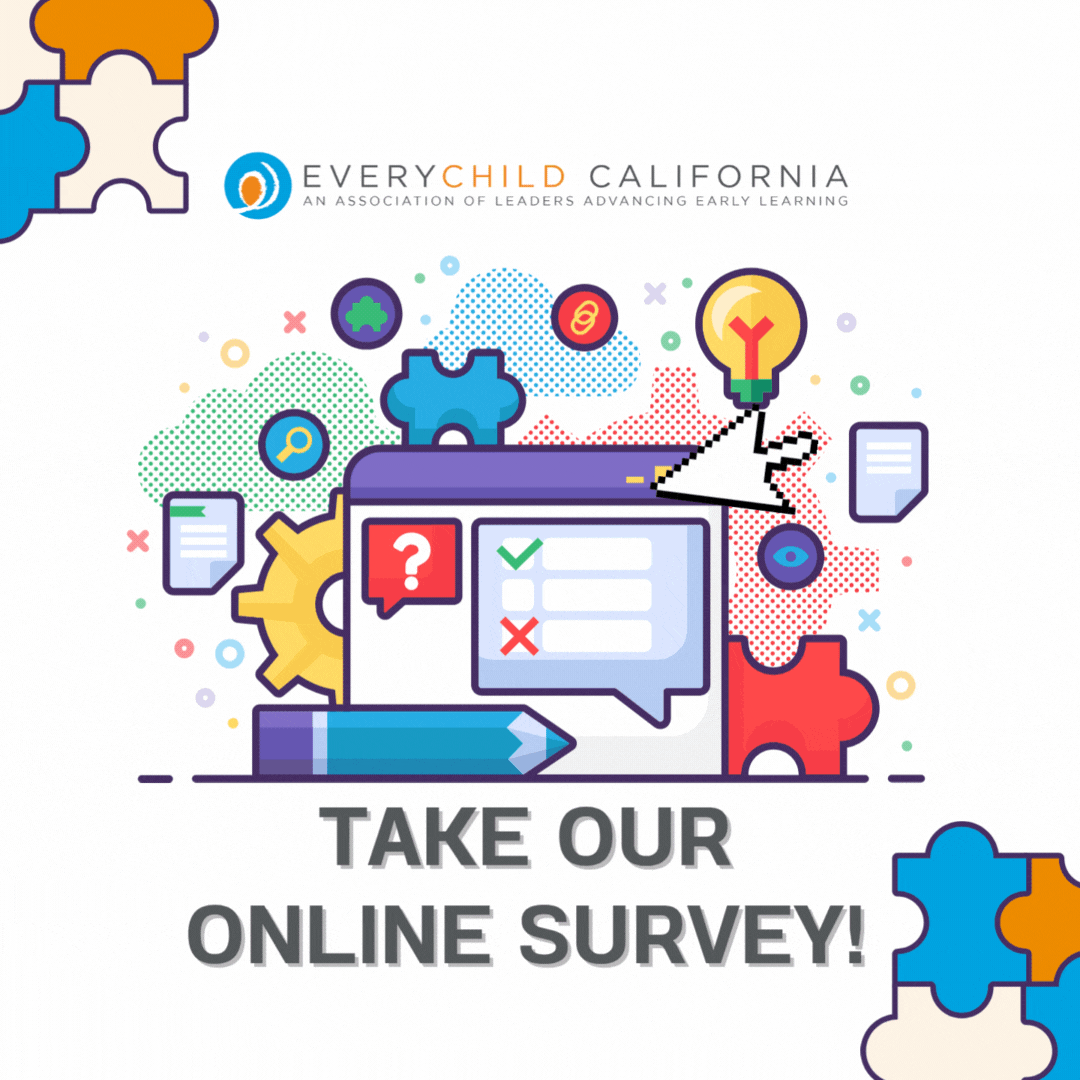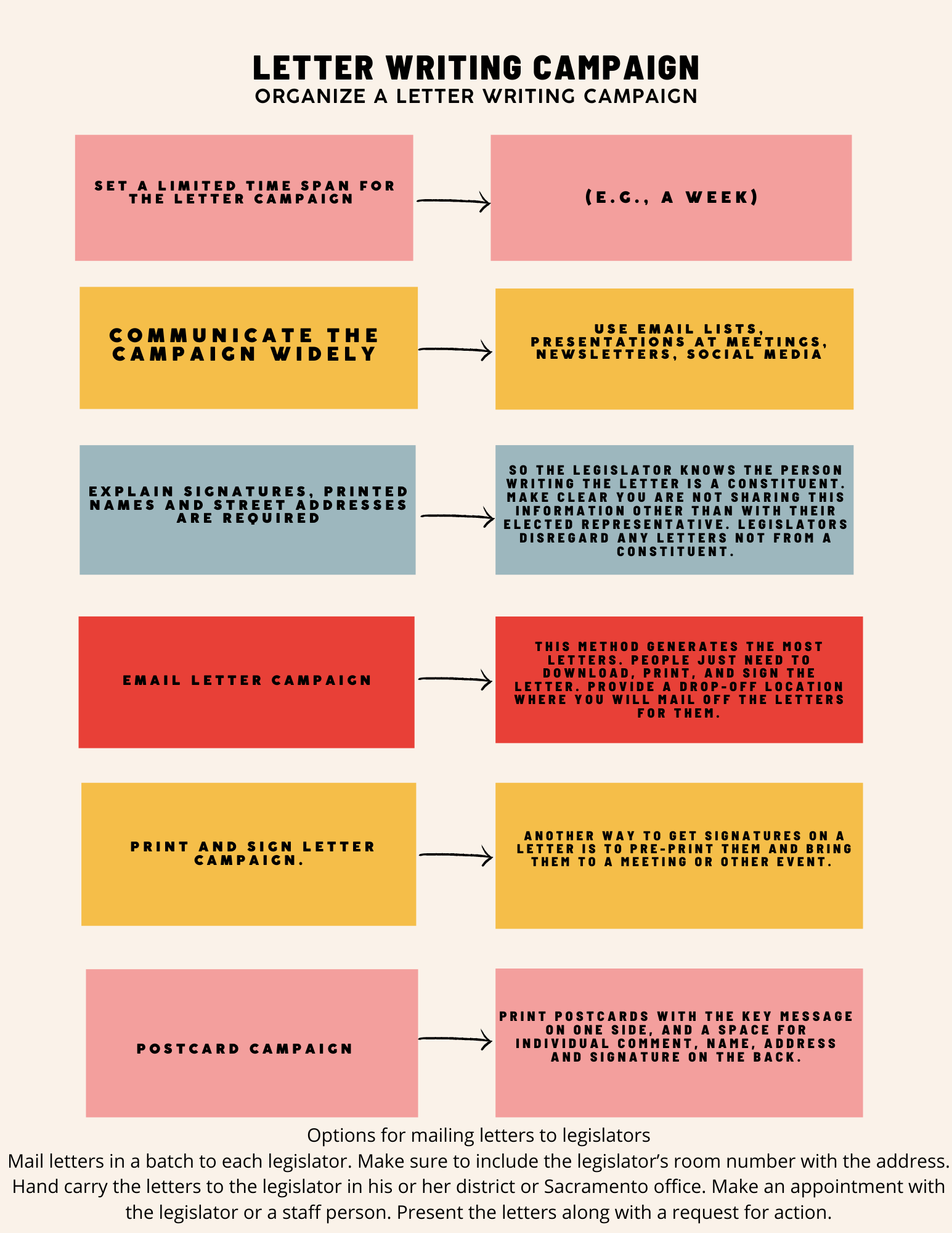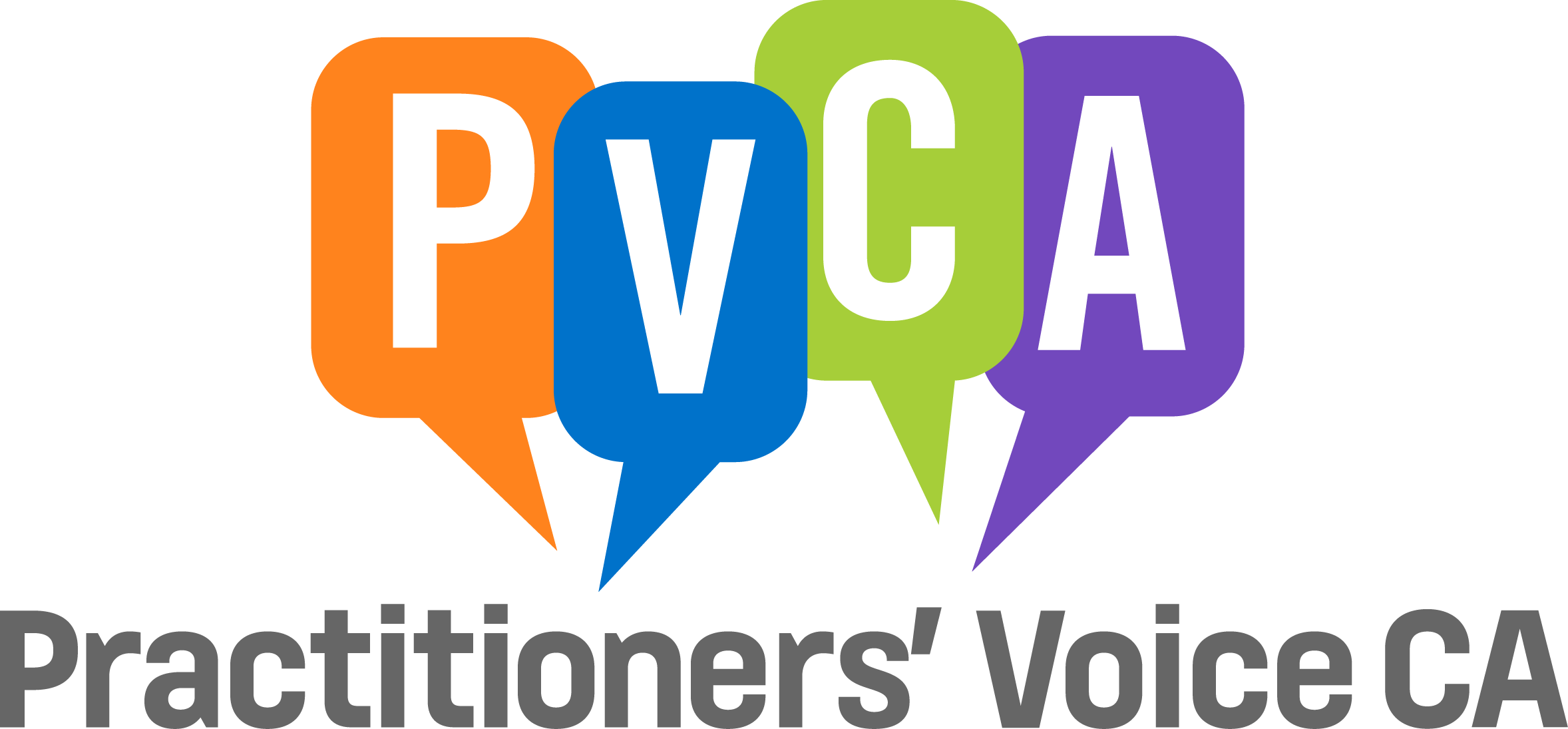Advocacy Toolkit/Herramientas para Abogar
Below is a collection of courses and resources from EveryChild California, On the Capitol Doorstep, and other stakeholders invested in advocating for publicly funded early learning and care programs across California.
Click here and Click here to access recordings, handouts, and resources for all of the advocacy training hosted through Zoom.
A continuación, encontrará una colección de cursos y recursos de EveryChild California, On the Capitol Doorstep y otras partes interesadas comprometidas con la defensa de los programas de aprendizaje y cuidado infantil financiados con fondos públicos en todo California.
Haga clic aquí para acceder a grabaciones, folletos y recursos de todas las capacitaciones acerca de como abogar a través de Zoom desde octubre de 2023 hasta diciembre de 2023.
Haga clic aquí para acceder a todas las grabaciones y recursos de todas las capacitaciones virtuales acerca de como abogar a través de Zoom de enero a marzo de 2024.
Rate Reform: Establish an Alternate Methodology Cost of Care Reimbursement and allocate ongoing funding for the new rate system.
ISSUE:
• Current rates are based on a percentage of the private market and not based on the true cost of care
• California is one the first states to make this transformative shift for justice in child care, and we need to keep up the promise of reform in this area.
REQUEST:
• Implement a cost-based rate system that reimburses ECE providers for 100% of the true cost of care based on the Federal requirement of child’s authorized enrollment and allocate ongoing funding for the new rate system.
Contract Earnings: Reimburse Child Care Programs Based on Certified Enrollment
ISSUE:
• Contract earnings based on enrollment was implemented during COVID-19 when attendance at child care programs was negatively impacted due to the pandemic. This expires on June 30, 2025.
• In 2024, Federal Child Care and Development Fund rules changed, requiring states and territories to pay a child care provider's reimbursement of a child's authorized enrollment.
REQUEST:
• Reimburses ECE providers based on the Federal requirement of child’s authorized enrollment.
Slot Release: Fulfill the Promise of 200,000 Additional Child Care Spaces
ISSUE:
• Only 1 in 9 children eligible for subsidized child care programs receives services.
REQUEST:
• Follow through on the promise of 200,000 additional child care spaces by 2027 to ensure resources are available to work toward ensuring that
every eligible child has access to child care, particularly in regions where unmet need is higher.
Click here for talking points to use when speaking to your representatives. Don't know who your representative is? Go to: www.findyour rep.legislature.ca.gov.
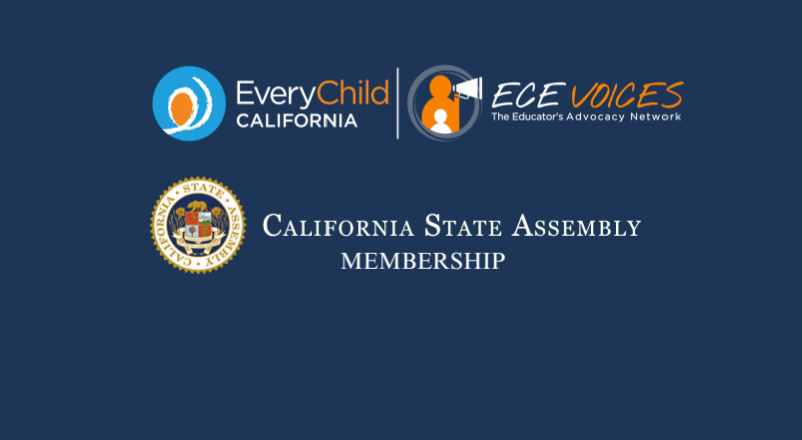
Click the picture above to access a listing of all Assemblymembers.
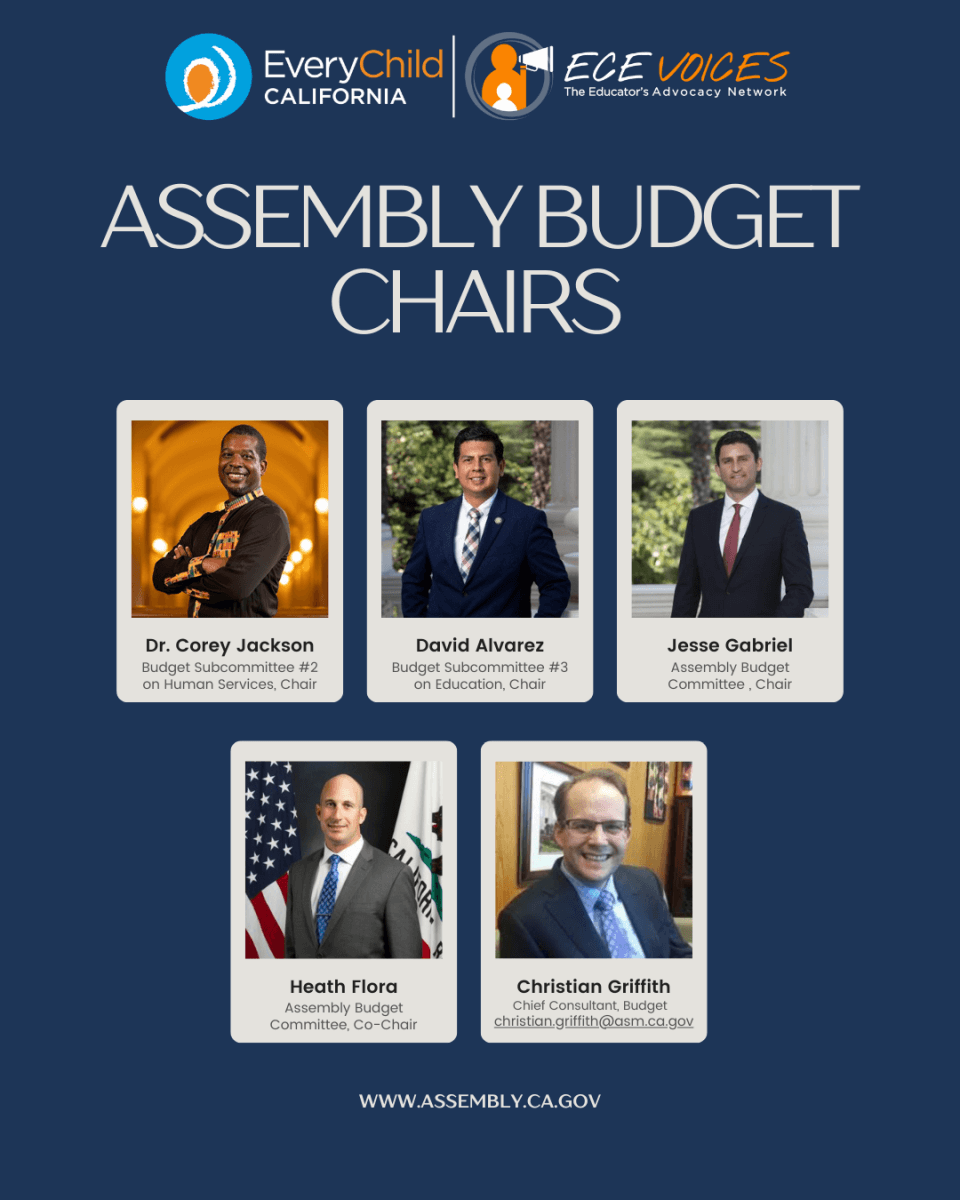
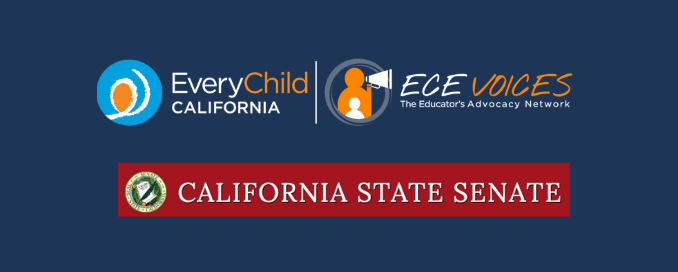
Click the picture above to access a list of all Senators.

As a bill becomes law, it first is heard in committees, and changes are made to it. Bills always start in their house of origin, meaning if it's an Assembly bill, it will first be assigned to Assembly committees where the public can provide input. If it makes it out of its house of origin, it moves to the other house, where it begins the process again. Most early childhood education bills are heard in Human Services and Education committees. This is important to know so that support letters can be submitted on time and agendas can be found for their hearings.
Cuando un proyecto de ley se convierte en ley, primero se presenta en comités donde se le realizan modificaciones. Los proyectos de ley siempre comienzan en su cámara de origen, lo que significa que si es un proyecto de ley de la Asamblea, primero se asignará a los comités de la Asamblea donde el público puede dar su opinión. Si logra salir de su cámara de origen, pasa a la otra, donde comienza el proceso nuevamente. La mayoría de los proyectos de ley sobre educación infantil temprana se debaten en los comités de Servicios Humanos y Educación. Es importante saber esto para que las cartas de apoyo se puedan enviar a tiempo y se puedan encontrar los calendarios de sus audiencias.
| Committee/Comité |
Committee Chair/
Titular del comité
|
Hearing Schedule/Calendario de Audiencias |
Support Letter Deadlines/Plazos para Cartas de Apoyo |
Location/ubicación |
|
Senate Education Committee
Comité de Educación del Senado
|
Senator Sasha Renée Pérez (D-Alhambra), Chair
Senator Rosilicie Ochoa Bogh (R- Yucaipa), Vice-Chair
|
The Senate Education Committee meets every Wednesday at 9:00 am in Room 2100.
La Comisión de Educación del Senado se reúne todos los miércoles a las 9:00 horas en la Sala 2100
|
Support and opposition letters are due by 12:00 noon the Friday prior to a scheduled hearing in order to be included in the analyses.
Las cartas de apoyo y oposición deben presentarse antes del mediodía del viernes anterior a la audiencia programada para ser incluidas en los análisis.
|
1021 O Street, Room 6740
Sacramento, CA 95814
Phone: (916) 651-4105
Email: SEDN.committee@senate.ca.gov
|
|
Senate Human Services Committee
Comité de Servicios Humanos del Senado
|
Senator Jesse Arreguín (D-Berkeley), Chair
Senator Rosilicie Ochoa Bogh (R-Yucaipa), Vice-Chair
|
Human Services Committee Hearing days: 1st, 3rd and 5th Monday at 3:00 p.m. or upon adjournment of the session at 1021 O Street Room 2200
Días de Audiencia del Comité de Servicios Humanos: Primer, tercer y quinto lunes a las 3:00 p.m. o al término de la sesión, en 1021 O Street Sala 2200
|
Support and opposition letters must be received by the Committee no later than noon six days prior to the scheduled hearing on the bill in question
Las cartas de apoyo y oposición deben ser recibidas por el Comité a más tardar al mediodía seis días hábiles antes de la audiencia programada para el proyecto de ley en cuestión.
|
1020 N Street, Room 521
Sacramento, CA 95814
Phone: (916) 651-1524
Fax: (916) 266-9350 |
|
Assembly Education Committee
Comité de Educación de la Asamblea
|
Assemblymember Al Muratsuchi, Chair
Assemblymember Josh Hoover, Vice-Chair
|
|
Amendments deadline: 12:00 noon, the Monday of the week prior to the hearing date.
Position letter deadline: 5:00 p.m., the Tuesday of the week prior to the hearing date.
El plazo para presentar enmiendas es el mediodía del lunes anterior a la fecha de la audiencia.
El plazo para presentar cartas de posición es a las 5:00 p.m. del martes de la semana anterior a la fecha de la audiencia.
|
Legislative Office Building
Edificio de Oficinas Legislativas
1020 N Street, Room 159 Phone number: (916) 319-2087
|
|
Assembly Human Services Committee
Comité de Servicios Humanos de la Asamblea
|
Assemblymember Alex Lee, Chair
Assemblymember Leticia Castillo, Vice-Chair
|
|
The Advocates submission deadline for hearings is the Wednesday one week prior to the hearing date at 5:00 p.m.
El plazo para presentar los documentos de The Advocates para las audiencias es el miércoles de la semana anterior a la fecha de la audiencia, a las 5:00 p.m.
|
Legislative Office Building
1020 N Street, Room 124 Phone number: (916) 319-2089
|
Representatives have multiple ways to contact them. They have home office addresses located in the region they represent. They also have an address at the Sacramento Capitol building. From mid-September through December, they can be reached at their local offices, but during the legislative session, January through mid-September, it's best to contact them at the Capitol. Every representative has a homepage with additional information about what bills they support and an events page so you can see where they are going to be and you can join their activities.
Los representantes tienen múltiples formas de contacto. Cuentan con direcciones de oficina local ubicadas en la región que representan, así como una dirección en el edificio del Capitolio de Sacramento. De mediados de septiembre a diciembre, se les puede contactar en sus oficinas locales, pero durante la sesión legislativa, de enero a mediados de septiembre, es recomendable contactarlos en el Capitolio. Cada representante tiene una página web con información adicional sobre los proyectos de ley que apoyan y una página de eventos para que puedas ver dónde estarán y unirte a sus actividades.
This will also provide information about what committees they participate in. This can be important when tracking a bill through the legislative process. If your representative sits on a committee that will hear a bill that you support, you will want to contact them to let them know you would like them to support the bill. Sending support letters to the committee is also how you are officially recorded as a supporter of a bill.
Además, este documento ofrece información sobre los comités en los que participan los Senadores y Asambleístas. Esto puede ser crucial para seguir el proceso legislativo de un proyecto de ley.
Si su representante forma parte de un comité que evaluará un proyecto de ley que usted apoya, es recomendable contactarlo para hacerle saber su apoyo. Enviar cartas de apoyo al comité es la forma oficial de registrarse como partidario de un proyecto de ley.
The "Swing Space" is the term used for 1021 O Street in Sacramento, which is a building temporarily housing representatives while the Capitol is being renovated. Here is a guide that shows how to navigate the building.
"Swing Space" es el término utilizado para el edificio ubicado en 1021 O Street en Sacramento, que temporalmente alberga a los representantes mientras se renueva el Capitolio. Esta guía detalla cómo navegar por el edificio.
